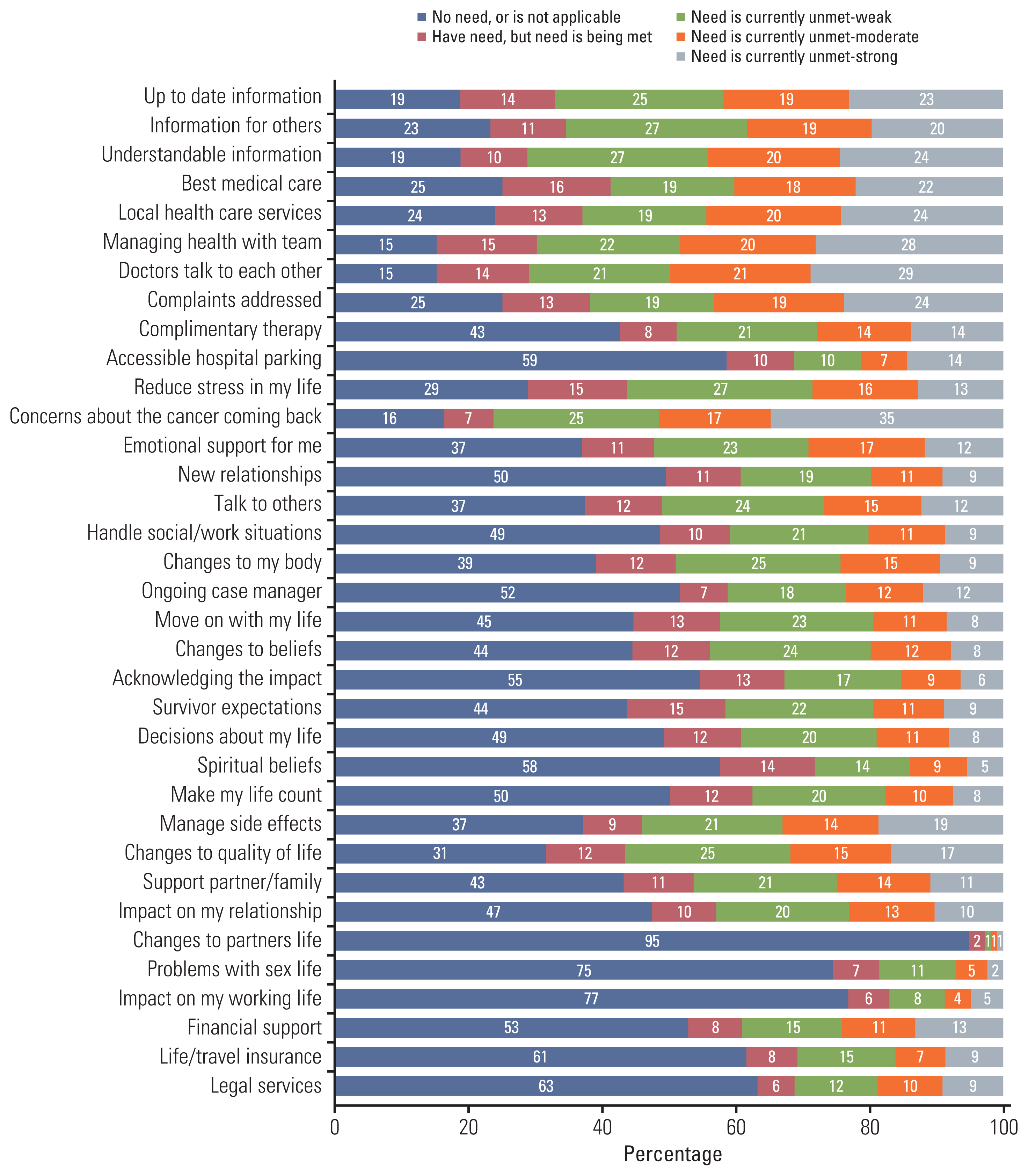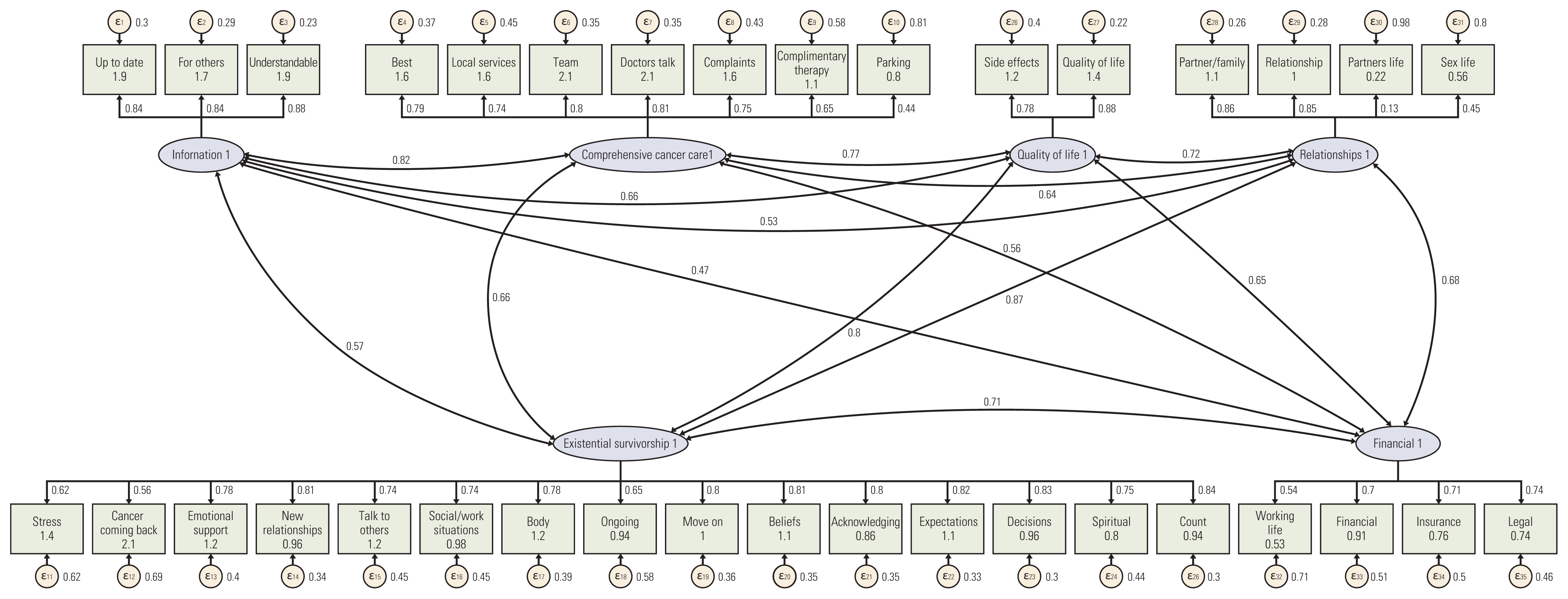Abstract
Purpose
Materials and Methods
Results
Notes
Ethical Statement
This study was approved by the Institutional Review Board (IRB) of Samsung Medical Center (IRB number: SMC 2018-09-037). All participants provided written informed consent prior to their participation.
Author Contributions
Conceived and designed the analysis: Kang D, Lee G, Shin DW, Cho J.
Collected the data: Lee G, Kim S, Nam H, Kong S, Shin S, Lee JK, Jung W, Shin S, Kim HK, Zo JI, Shim YM, Shin DW, Cho J.
Performed the analysis: Kang D, Shin S.
Wrote the paper: Kang D, Lee G, Kim S, Nam H, Kong S, Shin S, Lee JK, Jung W, Shin S, Kim HK, Zo JI, Shim YM, Shin DW, Cho J.
Acknowledgments
References
Table 1
Table 2
| Original dimension and item | Factor loading | Reliability of the dimension | ||
|---|---|---|---|---|
| F1 | F2 | F3 | ||
| Information | 0.89 | |||
| Up-to-date information | −0.0217 | 0.8203a) | −0.0859 | |
| Information for others | 0.0182 | 0.7763a) | −0.0255 | |
| Understandable information | −0.0307 | 0.8548a) | −0.053 | |
| Comprehensive cancer care | 0.87 | |||
| Best medical care | 0.0115 | 0.729a) | 0.0881 | |
| Local health care services | −0.0147 | 0.7051a) | 0.0578 | |
| Managing health with a team | −0.0847 | 0.8391a) | 0.0012 | |
| Doctors talk to each other | −0.0315 | 0.7884a) | 0.0138 | |
| Complaints are addressed | 0.0137 | 0.6911a) | 0.0484 | |
| Complimentary therapyb) | 0.0115 | 0.729a) | 0.0881 | |
| Accessible hospital parking | 0.0874 | 0.0572 | 0.5421a) | |
| Existential survivorship | 0.95 | |||
| Reduce stress in my life | 0.3074 | 0.428a) | 0.0932 | |
| Concerns about the cancer coming back | 0.3174 | 0.5086a) | −0.1399 | |
| Emotional support for me | 0.6598a) | 0.1981 | −0.0168 | |
| New relationships | 0.7705a) | −0.0034 | 0.0742 | |
| Talk to others | 0.6557a) | 0.1548 | −0.0212 | |
| Handle social/Work situations | 0.6714a) | 0.0198 | 0.0969 | |
| Changes to my body | 0.6846a) | 0.1512 | −0.0052 | |
| Ongoing case managerb) | 0.4a) | 0.1105 | 0.2596 | |
| Move on with my life | 0.7322a) | 0.008 | 0.0902 | |
| Changes to beliefs | 0.8443a) | 0.0019 | −0.0555 | |
| Acknowledging the impact | 0.8386a) | −0.0779 | 0.0292 | |
| Survivor expectations | 0.8563a) | 0.0547 | −0.1074 | |
| Decisions about my life | 0.9242a) | −0.053 | −0.0773 | |
| Spiritual beliefs | 0.8167a) | −0.1323 | 0.0369 | |
| Make my life count | 0.8835a) | −0.0833 | 0.0193 | |
| Quality of life | 0.81 | |||
| Manage side effects | 0.2481 | 0.4142a) | 0.1344 | |
| Changes to quality of life | 0.4183a) | 0.4124a) | 0.0468 | |
| Relationships | 0.68 | |||
| Support partner/Family | 0.5917a) | 0.1198 | 0.1378 | |
| Impact on my relationship | 0.6401a) | 0.0724 | 0.1007 | |
| Changes to partners lifeb) | −0.1312 | −0.0652 | 0.4262a) | |
| Problems with sex life | 0.3181a) | −0.0288 | 0.2455 | |
| Financial (new dimension) | 0.77 | |||
| Impact on my working lifeb) | 0.015 | −0.0658 | 0.5885a) | |
| Financial supportb) | 0.0993 | 0.0534 | 0.5716a) | |
| Life/Travel insuranceb) | 0.0751 | −0.0338 | 0.6517a) | |
| Legal servicesb) | 0.0924 | 0.0459 | 0.6259a) | |
Table 3
All numbers in this table were obtained via Pearson’s correlation analysis, p < 0.05. CaSUN-K, the Korean version of the Cancer Survivors’ Unmet Needs; EORTC QLQ-C30, European Organisation for Research and Treatment of Cancer Quality of Life Core Questionnaire; K-FCRI-SF, Korean version of the Fear of Cancer Recurrence Inventory-Short Form; QoL, quality of life.




 PDF
PDF Citation
Citation Print
Print





 XML Download
XML Download